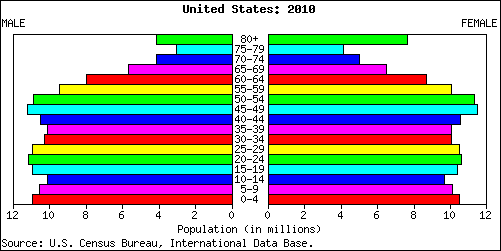Age-sex pyramids display the percentage or actual amount of a population broken down by gender and age. The five-year age increments on the y-axis allow the pyramid to vividly reflect long term trends in the birth and death rates but also reflect shorter term baby-booms, wars, and epidemics.
There are three key types of population pyramids:
1 - Rapid Growth

The population pyramid of the Philippines shows a triangle-shaped pyramid and reflects a high growth rate of about 2.1 percent annually.
2 - Slow Growth

In the United States, the population is growing at a rate of about 1.7 percent annually. This growth rate is reflected in the more square-like structure of the pyramid. Note the lump in the pyramid between the ages of about 35 to 50. This large segment of the population is the post-World War II "baby boom." As this population ages and climbs up the pyramid, there will be a much greater demand for medical and other geriatric services.
3 - Negative Growth
 Germany is experiencing a period of negative growth (-0.1%). As negative growth in a country continues, the population is reduced. A population can shrink due to a low birth rate and a stable death rate. Increased emigration may also be a contributor to a declining population.
Germany is experiencing a period of negative growth (-0.1%). As negative growth in a country continues, the population is reduced. A population can shrink due to a low birth rate and a stable death rate. Increased emigration may also be a contributor to a declining population..